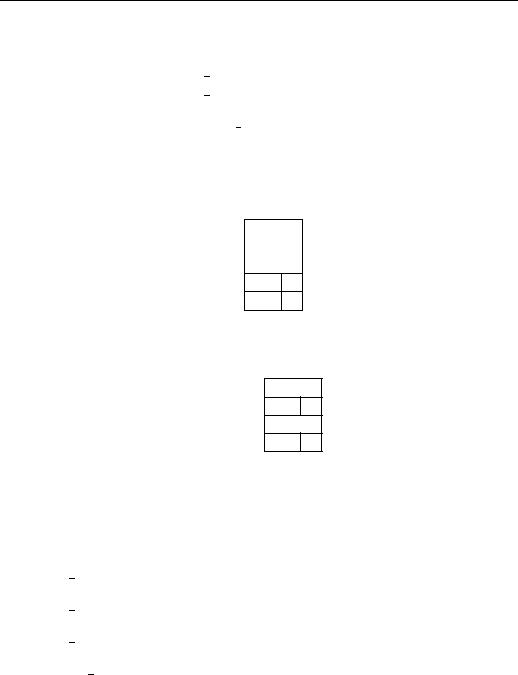
Ait-Kaci H.Warren's abstract machine.A tutorial reconstruction.1999
.pdf
WARREN’S ABSTRACT MACHINE
0h=2
1 |
REF |
1 |
2 |
REF |
2 |
|
|
|
3f=1
4 REF 2
5p=3
6 |
REF |
1 |
|
|
|
7 |
STR |
0 |
|
|
|
8 |
STR |
3 |
|
|
|
Figure 5.1: Better heap representation for term p(Z h (Z W ) (W ))
5.1 Heap representation
As many readers of [AK90] did, this reader may have wondered about the necessity of the extra level of indirection systematically introduced in the heap by an STR cell for each functor symbol. In particular, Fernando Pereira [Per90] suggested that instead of that shown in Figure 2.1 on Page 11, a more economical heap representation for p(Z h (Z W ) (W )) ought to be that of Figure 5.1, where reference to the term from elsewhere must be from a store (or register) cell of the form h STR 5 i. In other words, there is actually no need to allot a systematic STR cell before each functor cell.
As it turns out, only one tiny modification of one instruction is needed in order to accommodate this more compact representation. Namely, the put structure instruction is simplified to:
put |
|
structure f=n Xi HEAP[H] |
f=n |
|
|
Xi h STR |
H i |
|
|
H H + 1 |
|
Clearly, this is not only in complete congruence with WAM Principle 1, but it also eliminates unnecessary levels of indirection and hence speeds up dereferencing.
The main reason for our not having used this better heap representation in Section 2.1 was essentially didactic, wishing to avoid having to mention references from outside the heap (e.g., from registers) before due time. In addition, we did not bother bringing up this optimization in [AK90] as we are doing here, as we
PAGE 46 OF 129 |
Reprinted from MIT Press Copyright c Hassan A¨IT-KACI |

A TUTORIAL RECONSTRUCTION
had not realized that so little was in fact needed to incorporate it.1
5.2 Constants, lists, and anonymous variables
To be fully consistent with the complete WAM unification instruction set and in accordance with WAM Principle 3, we introduce special instructions for the specific handling of 0-ary structures (i.e., constants), lists, and variables which appear only once within a scope—so-called anonymous variables. These enhancements will also be in the spirit of WAM Principles 1 and 2 as savings in heap space, code size, and data movement will ensue.
Constants and lists are, of course, well handled by the structure oriented get, put, and unify instructions. However, work and space are wasted in the process, that need not really be. Consider the case of constants as, for instance, the code in Figure 2.10, on Page 24. There, the sequence of instructions:
unify variable X7 get structure a=0 X7
simply binds a register and proceeds to check the presence of, or build, the constant a on the heap. Clearly, one register can be saved and data movement optimized with one specialized instruction: unify constant a. The same situa-
1After dire reflection seeded by discussions with Fernando Pereira, we eventually realized that this optimization was indeed cheap—a fact that had escaped our attention. We are grateful to him for pointing this out. However, he himself warns [Per90]:
“Now, this representation (which, I believe, is the one used by Quintus, SICStus Prolog, etc.) has indeed some disadvantages:
1.If there aren’t enough tags to distinguish functor cells from the other cells, garbage collection becomes trickier, because a pointed-to value does not in general identify its own type (only the pointer does).
2.If you want to use [the Huet-Fages] circular term unification algorithm, redirecting pointers becomes messy, for the [same] reason...
In fact, what [the term representation in Section 2.1 is] doing is enforcing a convention that makes every functor application tagged as such by the appearance of a STR cell just before the functor word.”
Copyright c Hassan A¨IT-KACI Reprinted from MIT Press |
PAGE 47 OF 129 |

WARREN’S ABSTRACT MACHINE
tion in a query would simplify a sequence:
put structure c=0 Xi set variable Xi
into one specialized instruction set constant c. Similarly, put and get instructions can thus be specialized from those of structures to deal specifically with constants. Thus, we define a new sort of data cells tagged CON, indicating that the cell’s datum is a constant. For example, a heap representation starting at address 10 for the structure f(b g (a)) could be:
8 |
g=1 |
|
9 |
CON |
a |
10f=2
11CON b
12STR 8
Exercise 5.1 Could the following (smaller) heap representation starting at address 10 be an alternative for the structure f(b g(a))? Why?
10f=2
11CON b
12g=1
13CON a
Heap space for constants can also be saved when loading a register with, or binding a variable to, a constant. Rather than systematically occupying a heap cell to reference, a constant can be simply assigned as a literal value. The following instructions are thus added to I0:
1.put constant c Xi
2.get constant c Xi
3.set constant c
4.unify constant c
and are explicitly defined in Figure 5.2.
Programming with linear lists being so privileged in Prolog, it makes sense to tailor the design for this specific structure. In particular, non-empty list functors
PAGE 48 OF 129 |
Reprinted from MIT Press Copyright c Hassan A¨IT-KACI |

A TUTORIAL RECONSTRUCTION
put |
|
constant c Xi |
Xi |
h CON c i |
|
|
|
|||||
get |
|
constant c Xi addr |
deref (Xi) |
|
|
|||||||
|
|
|
|
|
case STORE[addr] of |
|
|
|||||
|
|
|
|
|
h REF |
|
i |
: |
STORE[addr] h CON c i |
|||
|
|
|
|
|
|
|
|
|
|
trail(addr) |
||
|
|
|
|
|
h CON c0 i : |
fail |
(c |
=6 c0) |
||||
|
|
|
|
|
other |
: |
fail |
true |
||||
|
|
|
|
|
endcase |
|
|
|
|
|||
set |
|
constant c |
HEAP[H] |
h CON c i |
|
|||||||
|
|
|
|
|
H |
H + 1 |
|
|
|
|
||
unify |
|
constant c case mode of |
addr deref (S) |
|||||||||
|
|
|
|
|
read : |
|||||||
|
|
|
|
|
|
|
|
|
case STORE[addr] of |
|||
|
|
|
|
|
|
|
|
|
( )endcase |
|||
|
|
|
|
|
write : |
HEAP[H] |
h CON c i |
|||||
|
|
|
|
|
|
|
|
|
H |
H + 1 |
|
|
|
|
|
|
|
endcase |
|
|
|
|
|||
|
|
|
|
|
|
|
|
|
|
|
|
|
Figure 5.2: Specialized instructions for constants
Copyright c Hassan A¨IT-KACI Reprinted from MIT Press |
PAGE 49 OF 129 |

WARREN’S ABSTRACT MACHINE
put |
|
list Xi Xi |
h LIS H i |
|
|||
get |
|
list Xi addr |
deref (Xi) |
|
|||
|
|
case STORE[addr] of |
|||||
|
|
h REF |
|
i : |
HEAP[H] h LIS H + 1 i |
||
|
|
|
|
|
|
bind(addr H) |
|
|
|
|
|
|
|
H H + 1 |
|
|
|
|
|
|
|
mode |
write |
|
|
h LIS a i : |
S |
a |
|||
|
|
|
|
|
|
mode |
read |
|
|
other |
: |
fail |
true |
||
|
|
endcase |
|
|
|
|
|
|
|
|
|
|
|
|
|
Figure 5.3: Specialized instructions for lists
need not be represented explicitly on the heap. Thus again, we define a fourth sort for heap cells tagged LIS, indicating that the cell’s datum is the heap address of the first element of a list pair. Clearly, to respect the subterm contiguity convention, the second of the pair is always at the address following that of the first. The following instructions (defined explicitly in Figure 5.3) are thus added to I0:
1.put list Xi
2.get list Xi
For example, the code generated for query ?-p(Z [Z W ] (W )):, using Prolog’s notation for lists, is shown in Figure 5.4 and that for fact p(f(X) [Y f (a)] ):, in Figure 5.5. Note the hidden presence of the atom [] as list terminator.
Of course, having introduced specially tagged data cells for constants and nonempty lists will require adapting accordingly the general-purpose unification algorithm given in Figure 2.7. The reader will find the complete algorithm in appendix Section B.2, on Page 117.
Exercise 5.2 In [War83], Warren also uses special instructionsput nil Xi, get nil Xi, and to handle the list terminator constant ([]). Define the effect of these instruc-
PAGE 50 OF 129 |
Reprinted from MIT Press Copyright c Hassan A¨IT-KACI |

A TUTORIAL RECONSTRUCTION
put list X5
set variable X6 set constant [] put variable X4 A1 put list A2
set value X4 set value X5
put structure f=1 A3 set value X6
call p=3
%?-X5 = [
%Wj
%[]]
%p(Z
%[
%Zj
%X5]
% |
f |
% |
(W) |
% |
): |
Figure 5.4: Specialized code for query ?-p(Z [Z W ] (W )):
p=3 : get |
|
structure f=1 A1 |
% |
p(f |
||
unify |
|
variable X4 |
% |
(X) |
||
get |
|
list A2 |
% |
[ |
||
unify |
|
variable X5 |
% |
Y j |
||
unify |
|
variable X6 |
% |
X6] |
||
get |
|
value X5 A3 |
% |
Y ) |
||
get |
|
list X6 |
% |
X6 = [ |
||
unify |
|
variable X7 |
% |
X7j |
||
unify |
|
constant [] |
% |
[]] |
||
get |
|
structure f=1 X7 |
% |
X7 = f |
||
unify |
|
constant a |
% |
(a) |
||
proceed |
% |
: |
||||
|
|
|
|
|
|
|
Figure 5.5: Specialized code for fact p(f(X) [Y f (a)] ):
Copyright c Hassan A¨IT-KACI Reprinted from MIT Press |
PAGE 51 OF 129 |

WARREN’S ABSTRACT MACHINE
tions, and give explicit pseudo-code implementing them. Discuss their worth being provided as opposed to using put constant [] Xi, get constant [] Xi, set constant [], and unify constant [].
Last in the rubric of specialized instructions is the case of single-occurrence variables in non-argument positions (e.g., X in Figure 2.4 on Page 16, Figure 2.10 on Page 24, and Figure 5.5 on Page 51). This is worth giving specialized treatment insofar as no register need be allocated for these. In addition, if many occur in a row as in f( ), say, they can be all be processed in one swoop, saving in generated code size and time. We introduce two new instructions:
1.set void n
2.unify void n
whose effect is, respectively:
1.to push n new unbound REF cells on the heap;
2.in write mode, to behave as set void n and, in read mode, to skip the next n heap cells starting at location S.
These are given explicitly in Figure 5.6.
Note finally, that an anonymous variable occurring as an argument of the head of a clause can be simply ignored. Then indeed, the corresponding instruction:
get variable Xi Ai
is clearly vacuous. Thus, such instructions are simply eliminated. The code for
fact p( |
|
(X) ( |
|
|
|
)):, for example, shown in Figure 5.7, illustrates this point. |
||||||
Exercise 5.3 |
What is the machine code generated for the fact p( |
|
|
|
|
|
):? What |
|||||
about the query ?-p( ):?
5.3 A note on set instructions
Defining the simplistic language L0 has allowed us to introduce, independently of other Prolog considerations, all WAM instructions dealing with unification.
PAGE 52 OF 129 |
Reprinted from MIT Press Copyright c Hassan A¨IT-KACI |

A TUTORIAL RECONSTRUCTION
set |
|
void n for i |
H to H + n ; 1 do |
|||
|
|
|
|
HEAP[i] |
h REF i i |
|
|
|
|
|
H |
H + n |
|
unify |
|
void n case mode of |
|
|||
|
|
|
|
read : S |
S + n |
|
|
|
|
|
write : for i H to H + n ; 1 do |
||
|
|
|
|
|
|
HEAP[i] h REF i i |
|
|
|
|
|
H |
H + n |
|
|
|
|
endcase |
|
|
|
|
|
|
|
|
|
Figure 5.6: Anonymous variable instructions
p=3 : get |
|
structure g=1 A2 |
% |
p( |
|
g |
||||||
unify |
|
void 1 |
% |
|
|
(X) |
||||||
get |
|
structure f=3 A3 |
% |
|
|
f |
||||||
unify |
|
void 3 |
% |
|
|
( |
|
Y |
|
) |
||
proceed |
% |
): |
||||||||||
|
|
|
|
|
|
|
|
|
|
|
|
|
Figure 5.7: Instructions for fact p( |
|
(X) ( |
|
|
|
)): |
Copyright c Hassan A¨IT-KACI Reprinted from MIT Press |
PAGE 53 OF 129 |

WARREN’S ABSTRACT MACHINE
Strictly speaking, the set instructions we have defined are not part of the WAM as described in [War83] or in [War88]. There, one will find that the corresponding unify instructions are systematically used where we use set instructions. The reason is, as the reader may have noticed, that indeed this is possible provided that the put structure and put list instructions set mode to write. Then, clearly, all set instructions are equivalent to unify instructions in write mode. We chose to keep these separate as using set instructions after put instructions is more efficient (it saves mode setting and testing) and makes the code more perspicuous. Moreover, these instructions are more natural, easier to explain and motivate as the data building phase of unification before matching work comes into play.
Incidentally, these instructions together with their unify homologues, make “on- the-fly” copying part of unification, resulting in improved space and time consumption, as opposed to the more na¨ıve systematic copying of rules before using them.
5.4 Register allocation
As in conventional compiler technology, the code generated from the source may give rise to obviously unnecessary data movements. Such can be simplified away by so-called “peep-hole” optimization. This applies to this design as well. Con-
sider for example the na¨ıve translation of the fact ‘conc([] |
):’: |
|||
conc=3 : get |
|
constant [] A1 |
% conc([] |
|
get |
|
variable X4 A2 |
% |
L |
get |
|
value X4 A3 |
% |
L) |
proceed |
% |
: |
||
Now, there is clearly no need to allocate register X4 for variable L since its only use is to serve as temporary repository—but so can A2. Thus, the get variable becomes get variable A2 A2, and can be eliminated altogether, yielding better code:
conc=3 : get |
|
constant [] A1 |
% |
conc([] |
get |
|
value A2 A3 |
% |
L L ) |
proceed |
% |
: |
||
More generally, since argument and temporary variable registers are the same, the
PAGE 54 OF 129 |
Reprinted from MIT Press Copyright c Hassan A¨IT-KACI |

A TUTORIAL RECONSTRUCTION
p=2 : allocate 2 |
% |
p |
||
get |
|
variable Y1 A2 |
% |
(X Y ) :- |
put |
|
variable Y2 A2 |
% |
q(X Z |
call q=2 |
% |
) |
||
put |
|
value Y2 A1 |
% |
r(Z |
put |
|
value Y1 A2 |
% |
Y |
call r=2 |
% |
) |
||
deallocate |
% |
: |
||
|
|
|
|
|
Figure 5.8: Better register use for p(X Y ) :- q(X Z ) (Z Y ):
following instructions are vacuous operations:
get variable Xi Ai put value Xi Ai
and can be eliminated. For example, looking back at the example shown in Figure 3.1 on Page 31, we realize that the temporary variable X is the first argument in the head as well as the first atom in the body. Therefore, allocating register X3 to the variable X is clearly silly as it has for consequence the useless movement of the contents of register A1 to X3, then back, as well as two more instructions increasing the code size. Thus, with this observation, it makes sense to allocate register A1 to X and apply the above vacuous operation elimination, resulting in the obviously better instruction sequence shown in Figure 5.8.
Register allocation must try to take advantage of this fact by recognizing situations when appropriate argument registers may also safely be used as temporary variables. Algorithms that do this well can be quite involved. A general method due to Debray [Deb86] works well in reasonable time. A more sophisticated but more (compile-time) expensive technique using Debray’s method combined with a reordering of unification instructions can be found in [JDM88]. Register allocation is really auxiliary to the WAM design and can be performed by an independent module in the compiler.
In the sequel, we shall implicitly use this optimization whenever better than na¨ıve register allocation can be obviously inferred by the reader.
Copyright c Hassan A¨IT-KACI Reprinted from MIT Press |
PAGE 55 OF 129 |
